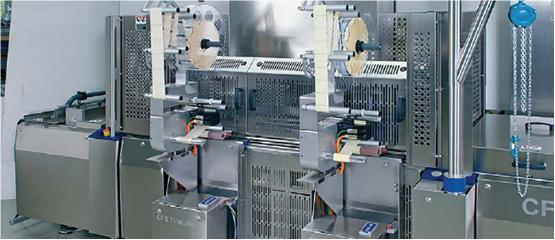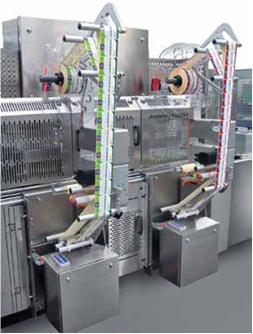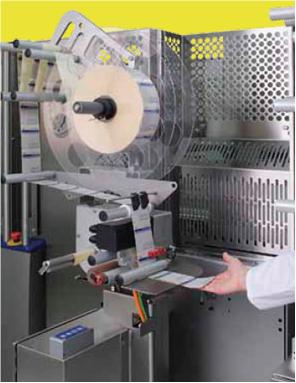Foreword: For food processing lines, it is not only inconvenient and costly to stop the label roll or stop the substrate due to tearing of the substrate. Therefore, CFS has proposed a concept that allows the label roll to be replaced without interrupting the machine. The new labeler has a fully modular structure to meet a wide range of application requirements. Up to 16 ACOPOS servo motors from B&R and control and display technology provide the necessary dynamics and labeling accuracy. Very simple. After the innovative design of the new TiroLabelNT labeler, once the label roll on the first stripper is empty, the label unit will quickly move to the second stripper to continue working – and then without interrupting the machine. In the case of the empty stripping machine, the label roll is easily loaded. In the labeling device, 16 B&R ACOPOS series intelligent servo drives are used to control the motor. The device can also attach two different labels during a labeling process. The use of servo motors prevents unnecessary label tape loosening and vibration. For the distributed architecture chosen by CFS, B&R drives are best supported: each modular stripping unit has its own power distribution cabinet, and in addition to the drives, the I/O modules are also from B&R. “Whether it's an ACOPOS drive or an X20 I/O system, it's very space-saving. Even drives for linear motors are very small,†Brandt said with great enthusiasm.
“On a typical luncheon meat or cheese processing line, 7.5% to 12% of downtime is caused by labeling equipment,†explains Michael Brandt, label and print product manager at CFS Germany GmbH in Wallau, Germany. Most of the downtime is spent on replacing the label roll. Considering the typical speed of high-performance packaging machinery (the label reel can be rotated 8 times per minute, 16 labels can be attached per turn), in fact, a roll of 5,000 labels can be used up in 40 minutes. Surprisingly, if a heat transfer machine is used, then additional downtime is required to replace the ribbon. If the label substrate is particularly thin, particularly soft, or uses a perforated label, conventional machinery faces some other problems and stops for unexpected substrate tearing.
Stripping machine and labeling unit are separated
Packaging machinery and labeling specialists at the CFS Competitiveness Center in Wallau solved this problem by proposing a new concept and applying it to the new labeling machine TiroLabelNT. This labeling system is the first pressure-sensitive labeler on the market that allows the label roll to be replaced while the machine is running. The machine's innovation is the creation of two separate stripping and labeling units that were previously concentrated in one machine structure. The movable labeling unit removes the labels from the fixed stripper and places them on the product, and finally the spring-loaded “manipulator†presses the label onto the product.
Machines with two stripping units allow the label reel to be replaced without interrupting the operation of the equipment: in order to achieve this, the machine must be constructed and programmed accordingly, once the first stripping machine is on the label reel When empty or the ribbon is used up, the labeling unit can automatically move to the second stripping machine. Since the label reel can be mounted on the empty stripping machine while the second stripping machine is running, the machine is guaranteed to run continuously. Thanks to B&R's advanced modular system and revolutionary drive and control technology, Michael Brandt and his CFS team successfully achieved this innovation. 
Flexible configuration
Due to the different downtime caused by the replacement of the label roll on each line, CFS offers a variety of models of the TiroLabelNT labeler. The entry-level TiroLabelNT 201 has a stripping machine and a labeling unit; the TiroLabelNT 202 with two stripping machines and one labeling unit can produce between 120 and 170 packages per minute; the high-end product TiroLabelNT 203 with two stripping machines And two labeling units for the most demanding applications.
“Labeling equipment with two stripping machines has more uses than simply reducing downtime,†Brandt emphasizes. “Users can also attach a second promotional label to the product, such as 'buy 1 get 1 free' or 'immediately discount 20% or more', thus saving extra time and effort.†If two stripping machines and one labeling If the unit is not enough, then you can also choose a labeling machine with two labeling units.
B&R technology makes it come true
The new TiroLabelNT machine concept can only be achieved with new technology: since the stripping machine and the labeling machine are no longer integrated, and the machine is running, the stripping machine needs to be fixed in an optimal position to ensure a specific packaging form, so After each cycle, the labeling unit must return to the stripper. “In order to achieve the same output as conventional equipment, the labeling unit must move faster than ever,†explains Brandt. “That's why our labeler uses a linear motor that can drive the labeling unit with an acceleration of 2g. In addition to increasing production, this is an absolutely maintenance-free technology because it does not require parts such as toothed belts. Therefore, unnecessary wear is avoided." The motor is controlled by the B&R ACOPOS series of intelligent servo drives. “B&R immediately agreed to proceed with the integration of linear motors and the creation of related driver software. We are convinced that we chose B&R, we not only trust their control and display technology – as we all have, and we trust Their drive technology," Brandt said. For TiroLabelNT, the application of drive technology is very extensive: the labeling system uses a total of 16 servo motors. 
Roll drive instead of mechanical coupling
The stripping unit requires two servo motors (or ACOPOS drives) separately: like the labeling unit, the stripping unit must also run faster to avoid unnecessary delays. Here, the servo replaces the stepper motor that unwinds the label roll, and the mechanical coupling used to rewind the roll has also been replaced by the servo motor. “Even with more modern label substrates at higher speeds, the servo system's torque control prevents unnecessary label tape loosening and vibration. In short, the system handles the material in a softer way,†adds Brandt. 
The control function of the labeling machine is provided by the control system of the upstream packaging machine (PowerpakNT or PowerpakRT thermoforming machine). The control and display solution is based on the B&R APC620, which has been widely used as a standardized component in CFS equipment. The architecture of the thermoforming machine has been established, so the only thing that needs to be done when adding the labeling machine is to add a Hub to the POWERLINK network. If necessary, the architecture can be further extended to include more labeling machines, with no changes to the distribution cabinets of the packaging machinery.
Simulation and code generation with MATLAB®/Simulink®
TiroLabelNT's modernization philosophy and technology match the advanced development tools and processes used by CFS engineers. “It’s difficult to develop control software for machines like TiroLabelNT in a traditional way, no matter the order of motion or software management,†explains Brandt. “That's why we use MATLAB®/Simulink® to develop mechanical structures, process sequences, timing processing, and generate control programs.†This ensures that the throughput achieved in the simulation can also be done in real-world situations. The CFS experts are passionate about the benefits users benefit from: “Operators can directly enter the number of tags they want for a package and get instant feedback on whether it is achievable. If it can, the controller will All relevant parameters are automatically set. In the past, the way the machine stopped after gradually completing the expected amount of packaging has been eliminated.†Since each labeling unit works at a reasonable speed to complete a specified number of labels, this also prevents Mechanical damage and improved labeling accuracy.
In short, replacing the traditional labeling scheme with a new labeling system means that the machine has higher processing power, achieves higher precision, and saves more resources and space. In addition, the label reel can be placed outside the safety cover, machine cleaning is easier, and the reel change is more ergonomic.